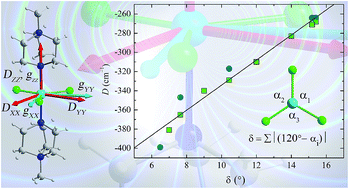当前位置:
X-MOL 学术
›
Chem. Sci.
›
论文详情
Our official English website, www.x-mol.net, welcomes your
feedback! (Note: you will need to create a separate account there.)
Probing the origin of the giant magnetic anisotropy in trigonal bipyramidal Ni(ii) under high pressure†
Chemical Science ( IF 7.6 ) Pub Date : 2017-12-19 00:00:00 , DOI: 10.1039/c7sc04460g Gavin A Craig 1 , Arup Sarkar 2 , Christopher H Woodall 3, 4 , Moya A Hay 1 , Katie E R Marriott 1 , Konstantin V Kamenev 3, 4 , Stephen A Moggach 3, 4 , Euan K Brechin 3, 4 , Simon Parsons 3, 4 , Gopalan Rajaraman 2 , Mark Murrie 1
Chemical Science ( IF 7.6 ) Pub Date : 2017-12-19 00:00:00 , DOI: 10.1039/c7sc04460g Gavin A Craig 1 , Arup Sarkar 2 , Christopher H Woodall 3, 4 , Moya A Hay 1 , Katie E R Marriott 1 , Konstantin V Kamenev 3, 4 , Stephen A Moggach 3, 4 , Euan K Brechin 3, 4 , Simon Parsons 3, 4 , Gopalan Rajaraman 2 , Mark Murrie 1
Affiliation

|
Understanding and controlling magnetic anisotropy at the level of a single metal ion is vital if the miniaturisation of data storage is to continue to evolve into transformative technologies. Magnetic anisotropy is essential for a molecule-based magnetic memory as it pins the magnetic moment of a metal ion along the easy axis. Devices will require deposition of magnetic molecules on surfaces, where changes in molecular structure can significantly alter magnetic properties. Furthermore, if we are to use coordination complexes with high magnetic anisotropy as building blocks for larger systems we need to know how magnetic anisotropy is affected by structural distortions. Here we study a trigonal bipyramidal nickel(II) complex where a giant magnetic anisotropy of several hundred wavenumbers can be engineered. By using high pressure, we show how the magnetic anisotropy is strongly influenced by small structural distortions. Using a combination of high pressure X-ray diffraction, ab initio methods and high pressure magnetic measurements, we find that hydrostatic pressure lowers both the trigonal symmetry and axial anisotropy, while increasing the rhombic anisotropy. The ligand–metal–ligand angles in the equatorial plane are found to play a crucial role in tuning the energy separation between the dx2−y2 and dxy orbitals, which is the determining factor that controls the magnitude of the axial anisotropy. These results demonstrate that the combination of high pressure techniques with ab initio studies is a powerful tool that gives a unique insight into the design of systems that show giant magnetic anisotropy.
中文翻译:

探究高压下三角双锥体 Ni(ii) 巨磁各向异性的起源†
如果数据存储的小型化要继续发展为变革性技术,那么理解和控制单个金属离子水平的磁各向异性至关重要。磁各向异性对于基于分子的磁存储器至关重要,因为它将金属离子的磁矩沿易轴固定。设备需要在表面沉积磁性分子,其中分子结构的变化可以显着改变磁性。此外,如果我们要使用具有高磁各向异性的配位配合物作为更大系统的构建块,我们需要知道结构畸变如何影响磁各向异性。在这里,我们研究了一种三角双锥体镍(II)配合物,其中可以设计出数百波数的巨大磁各向异性。通过使用高压,我们展示了磁各向异性如何受到小的结构扭曲的强烈影响。结合高压 X 射线衍射、从头算方法和高压磁测量,我们发现静水压力降低了三角对称性和轴向各向异性,同时增加了菱形各向异性。研究发现,赤道面上的配体-金属-配体角在调节 d x 2 − y 2和 d xy轨道之间的能量分离方面发挥着至关重要的作用,这是控制轴向各向异性大小的决定因素。这些结果表明,高压技术与从头开始研究的结合是一种强大的工具,可以为显示巨大磁各向异性的系统设计提供独特的见解。
更新日期:2017-12-19
中文翻译:

探究高压下三角双锥体 Ni(ii) 巨磁各向异性的起源†
如果数据存储的小型化要继续发展为变革性技术,那么理解和控制单个金属离子水平的磁各向异性至关重要。磁各向异性对于基于分子的磁存储器至关重要,因为它将金属离子的磁矩沿易轴固定。设备需要在表面沉积磁性分子,其中分子结构的变化可以显着改变磁性。此外,如果我们要使用具有高磁各向异性的配位配合物作为更大系统的构建块,我们需要知道结构畸变如何影响磁各向异性。在这里,我们研究了一种三角双锥体镍(II)配合物,其中可以设计出数百波数的巨大磁各向异性。通过使用高压,我们展示了磁各向异性如何受到小的结构扭曲的强烈影响。结合高压 X 射线衍射、从头算方法和高压磁测量,我们发现静水压力降低了三角对称性和轴向各向异性,同时增加了菱形各向异性。研究发现,赤道面上的配体-金属-配体角在调节 d x 2 − y 2和 d xy轨道之间的能量分离方面发挥着至关重要的作用,这是控制轴向各向异性大小的决定因素。这些结果表明,高压技术与从头开始研究的结合是一种强大的工具,可以为显示巨大磁各向异性的系统设计提供独特的见解。











































 京公网安备 11010802027423号
京公网安备 11010802027423号